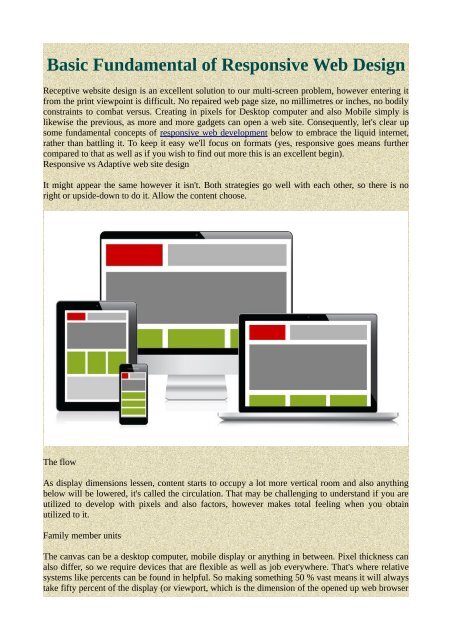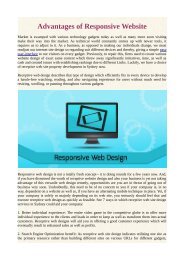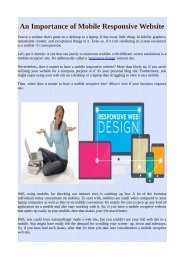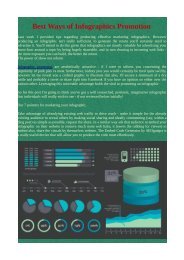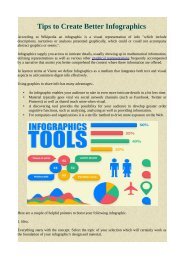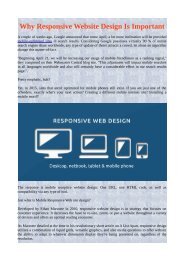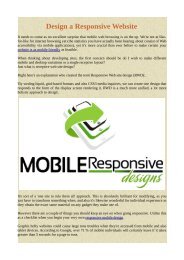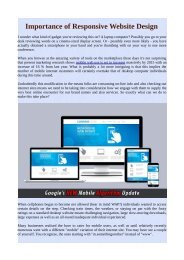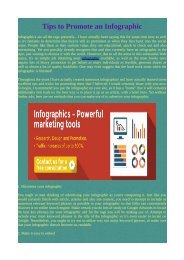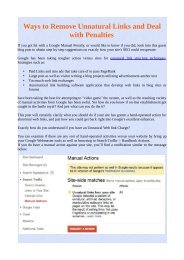Basic Fundamental of Responsive Web Design
Receptive website design is an excellent solution to our multi-screen problem, however entering it from the print viewpoint is difficult.
Receptive website design is an excellent solution to our multi-screen problem, however entering it from the print viewpoint is difficult.
Create successful ePaper yourself
Turn your PDF publications into a flip-book with our unique Google optimized e-Paper software.
<strong>Basic</strong> <strong>Fundamental</strong> <strong>of</strong> <strong>Responsive</strong> <strong>Web</strong> <strong>Design</strong><br />
Receptive website design is an excellent solution to our multi-screen problem, however entering it<br />
from the print viewpoint is difficult. No repaired web page size, no millimetres or inches, no bodily<br />
constraints to combat versus. Creating in pixels for Desktop computer and also Mobile simply is<br />
likewise the previous, as more and more gadgets can open a web site. Consequently, let's clear up<br />
some fundamental concepts <strong>of</strong> responsive web development below to embrace the liquid internet,<br />
rather than battling it. To keep it easy we'll focus on formats (yes, responsive goes means further<br />
compared to that as well as if you wish to find out more this is an excellent begin).<br />
<strong>Responsive</strong> vs Adaptive web site design<br />
It might appear the same however it isn't. Both strategies go well with each other, so there is no<br />
right or upside-down to do it. Allow the content choose.<br />
The flow<br />
As display dimensions lessen, content starts to occupy a lot more vertical room and also anything<br />
below will be lowered, it's called the circulation. That may be challenging to understand if you are<br />
utilized to develop with pixels and also factors, however makes total feeling when you obtain<br />
utilized to it.<br />
Family member units<br />
The canvas can be a desktop computer, mobile display or anything in between. Pixel thickness can<br />
also differ, so we require devices that are flexible as well as job everywhere. That's where relative<br />
systems like percents can be found in helpful. So making something 50 % vast means it will always<br />
take fifty percent <strong>of</strong> the display (or viewport, which is the dimension <strong>of</strong> the opened up web browser
window).<br />
Breakpoints<br />
Breakpoints allow the format to alter at predefined factors, i.e. having 3 columns on a desktop, yet<br />
simply 1 pillar on a mobile device. Many CSS properties could be transformed from one breakpoint<br />
to another. Generally where you put one depends upon the content. If a sentence breaks, you could<br />
need to bring in a breakpoint. But use them with caution-- it could acquire cluttered swiftly when<br />
it's challenging to understand just what is influencing exactly what.<br />
Max and Minutes worths<br />
Sometimes it's terrific that content takes up the whole size <strong>of</strong> a screen, like on a mobile device, yet<br />
having the very same content stretching to the whole width <strong>of</strong> your TELEVISION screen frequently<br />
earns less sense. This is why Min/Max values assist. For example having size <strong>of</strong> ONE HUNDRED<br />
% and also Max width <strong>of</strong> 1000px would suggest that material will certainly load the display,<br />
however don't go over 1000px.<br />
Nested items<br />
Remember the relative location? Having a lot <strong>of</strong> elements depending upon each other would be<br />
tough to handling, for that reason covering components in a container maintains it way a lot more<br />
reasonable, clean and tidy. This is where static systems like pixels can aid. They work for content<br />
that you don't wish to scale, like logos and buttons.<br />
Mobile or Desktop first<br />
Technically there isn't really much <strong>of</strong> a difference if a project is begun with a high street display to a<br />
larger (mobile initial) or vice versa (desktop computer very first). Yet it adds additional limitations<br />
and aids you make decisions if you begin with mobile first. Typically individuals begin with both<br />
ends simultaneously, so actually, go and see what works better for you.
<strong>Web</strong>fonts vs System font styles<br />
Wan na have an awesome looking Futura or Didot on your site? Use webfonts! Although they will<br />
certainly look magnificent, remember that each will be downloaded and the more you'll have, the<br />
longer it will require to load the web page. System typefaces on the various other hand are lightning<br />
fast, except when the customer doesn't have it in your area, it will drop back to a default font.<br />
Bitmap pictures vs Vectors<br />
Does your symbol have lot <strong>of</strong> specifics as well as some fancy effects applied? If yes, utilize a<br />
bitmap. If not, consider using a vector photo. For bitmaps make use <strong>of</strong> a jpg, png or a gif, for<br />
vectors the most effective selection would be a SVG or an icon font. Each has some advantages and<br />
some drawbacks. Nevertheless keep in mind the size-- no photos ought to browse the web without<br />
optimization. Vectors on the various other hand frequently are tiny, yet some older internet browsers<br />
won't assist it. Additionally, if it has great deals <strong>of</strong> contours, it might be heavier than a bitmap, so<br />
pick carefully.


